send feedback
in magic: the gathering’s defense, by the time the game became clearly “not for me”, i had already stopped playing. it is still “for” many other people and that’s ok. but nevertheless i think something was lost over time.
it’s odd to say something was lost, considering all the old cards still exist. but unlike almost every other game, it’s very expensive to actually get your hands on the game’s earliest cards. and it’s harder still to find opponents who will play, for example, “legacy as of 2014” (though niche formats like that seem to be gaining a bit of steam).
one mostly unique quality of MtG, compared to games as a whole, is that it the flow of new card designs can never stop. this is because players spend a lot more money on new cards than old ones, and Wizards of the Coast really likes money.
so first i’m going to discuss the consequences of MtG’s ever-expanding card pool, then i will discuss some other grievances with the game’s evolution, make an extended analogy to marvel, and eventually suggest a path forward as if Wizards of the Coast would listen for some reason.
what is so good about having more cards?
people like coming up with new decks. more cards means more possibilities for casual players to make the type of deck they find more fun, and it offers more variety for competitive players who would otherwise tire of a settled metagame.
and the beautiful thing about MtG compared to every other game is that its card pool is so large that you can do nearly anything you want with it. if you have a favorite mechanic, creature type, or character, you can almost always find enough cards to theme your whole deck around it. if you like inventing weird combos, you have gazillions of card interactions to consider. and if you want to invent a new way to play the game, or a novel set of cards to choose from, there’s a vast array of possibilities.1
more nebulously, it gives the impression that MtG is alive, something worth paying attention to in the present, as opposed to an old game that you can still play if you like.
what is so bad about having more cards?
people like non-rotating formats like Modern and Legacy. in Legacy, every card ever printed is legal, except for some designed for other MtG formats that don’t make sense in the normal rules, and some that are banned because they’re too good.2 Modern is similar but excludes cards that weren’t in a standard-legal set from 2003 or later. these formats are called “eternal” formats because every card that’s legal in them will be legal eternally (unless banned). and new cards are added all the time. so the set of cards available is ever-expanding.
this has some knock-on effects:
- when wizards of the coast prints a new powerful card, unless they’re careful it could allow a really really powerful combination with one of the tens of thousands of existing cards in those formats.
- the power level of the format is always increasing as new powerful cards are created.
- players complain when not enough new cards are useful in these eternal formats, which pressures WotC to print cards at ever-increasing power levels. this is called “power creep” and is near-universal among collectible card games.
players also want new designs to be distinct from older ones, so WotC is pressured to always do something new and different. as simpler, more elegant areas of MtG’s design space are exhausted, new cards tend to get more contrived. and even as they get more contrived, new mechanics feel no more novel; they feel less novel now than then, if anything.3
some other complaints about modern design trends
the aesthetic. magic: the gathering doesn’t look magical anymore. look at an old MtG card and compare to a new one. the new design style has several practical advantages, but the polish works against it in one critical way: the cards no longer feel magical. magical artifacts oughtn’t look sleek, modern, and corporate, with photographic-looking digital art. the fantasy of magic is old, and should look hand-illustrated with somewhat dated visual design. this is anathema to the modern corporation but i think it’s critical to evoke any sense of mysticism.
some examples
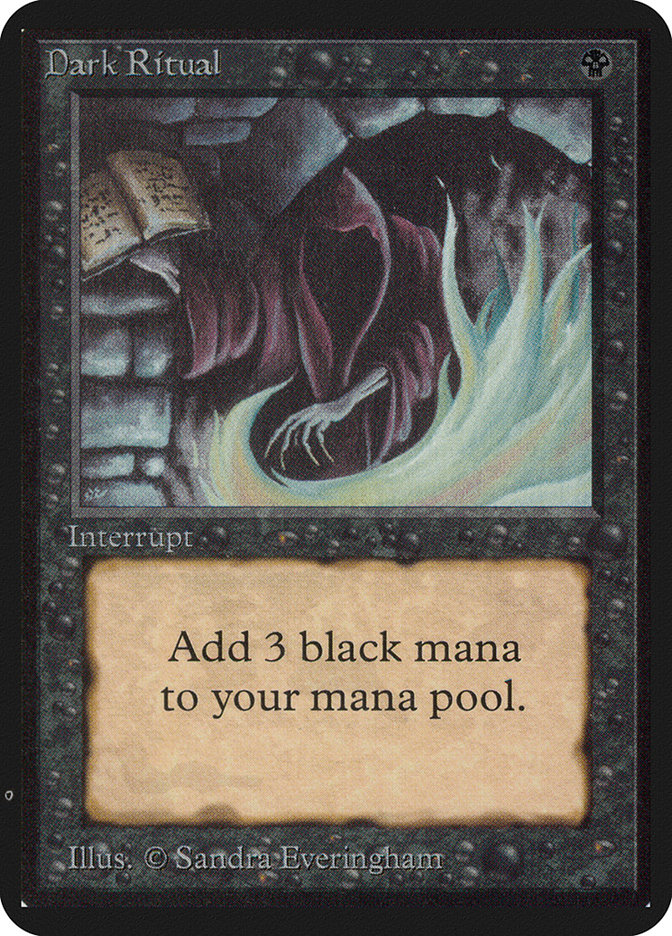
compare the very first printing of Dark Ritual…

…to the Planechase printing of it in 2009

or the very first printing of Lightning Bolt…
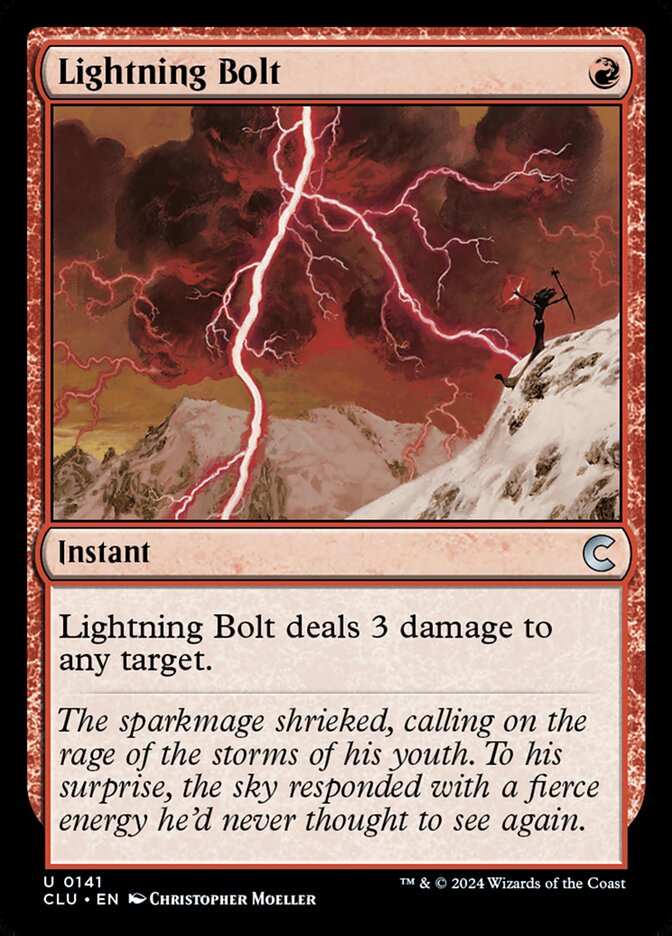
…to its printing in Ravnica: Clue Edition this year
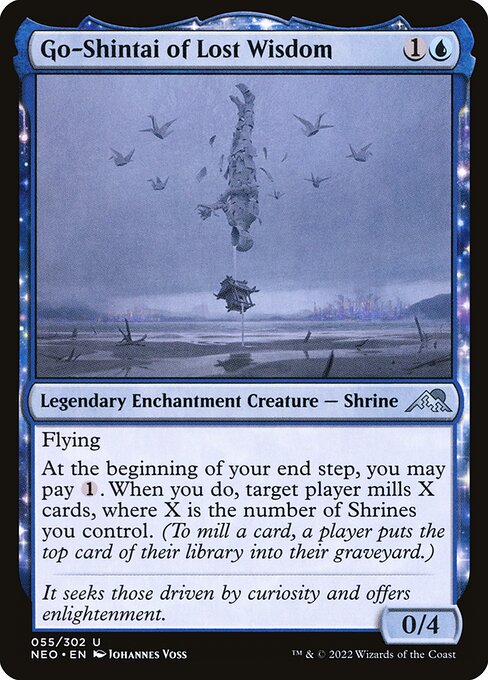
that’s not to say that there aren’t still good artworks…
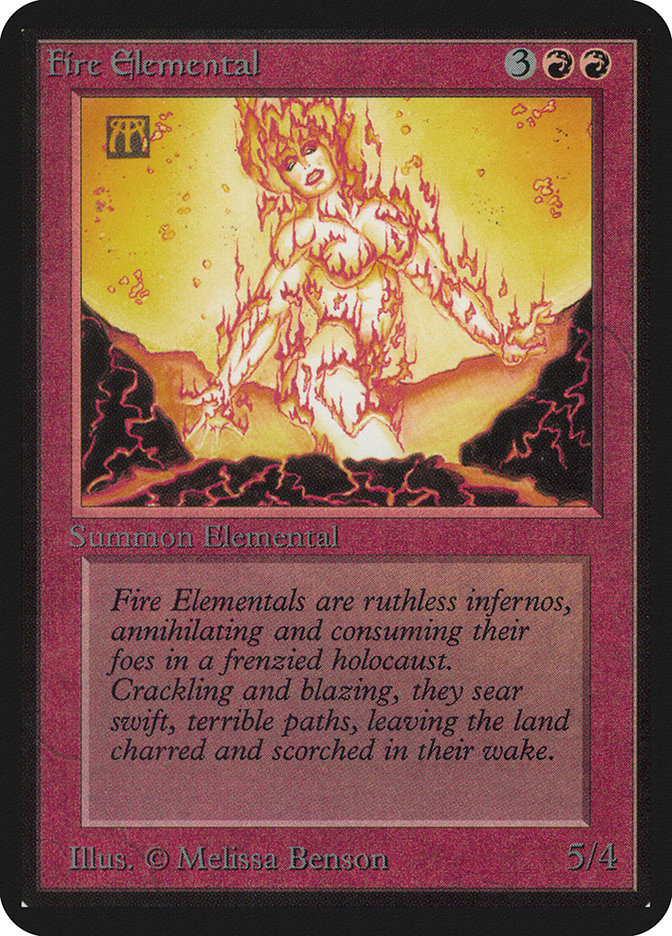
…or bad old ones
the release schedule. MtG releases several times more cards each year than it used to, which (in terms of time) burns through their design space far quicker. and by abandoning the “block” system, they have less reason to reuse themes and mechanics, forcing them to come up with novel ideas even more often. and besides my concerns about design space, it makes the game far harder to keep up with. “spoiler season”, when cards from an upcoming set are revealed, used to happen once every three months. now there are multiple spoiler seasons running concurrently at all times. as someone who only keeps loose tabs on the game, i find it hard to keep track of what’s happening anymore. for example, now when i hear about a set, i have no idea when it gets released (or whether it was released already).
wordiness. exploration of design space forces cards to become more contrived over time, as i discussed, but newer card designs are trending in that direction beyond reason, in my opinion. there are a couple smaller trends that lead to this phenomenon:
- some effects, most notably “impulse draw”, are convenient from a balance perspective but hard to template concisely.
- in surveys. players say they love cards that are kind of like two cards in one. (e.g., adventure cards, entwine cards, split cards.) the earliest designs, such as Tooth and Nail, were very simple, but WotC keeps pushing this trend further and including more and more text on these cards, resulting in cards like Fable of the Mirror-Breaker // Reflection of Kiki-Jiki or the infamous cycle of deans.
- WotC has generally stopped respecting the idea of keeping everything on one side of one card. part of the issue with the new double-faced cards they print is that it’s hard to remember what’s on the back side of the card. when the back side is simple it’s not so bad, but many new designs are egregious on this front.4 but worse yet, and buckle in because this is going to be a long bullet point, is the offloading of rules onto emblems or tokens which are not even present on the card. a common joking retort to rules questions is, “reading the card explains the card,” but sometimes that’s not even true! it’s one thing when digital games like Hearthstone and Slay the Spire do it, because they let you hover over the card to see what it’s referencing, but paper affords no such luxury. the Food and Clue tokens aren’t so bad, because they’re commonly used and simple, but emblems are worse, like “the ring tempts you” or worst of all dungeons and “the initiative”. when i first saw the initiative mechanic i didn’t know how it worked, so i looked for a card called “the initiative” but there isn’t one, so i had to look it up and i found out it’s actually a card called Undercity which has as much text as a quite complicated card unto itself, and has its own persistent state you have to track, and beyond that it was a little bit overpowered in Legacy! this is to say nothing of the 3 other equally complicated dungeons available. god i hate that mechanic.
- one of my favorite things in MtG is finding a card with a cool payoff and combining it with powerful ways to enable that payoff. but the recent design trend is for cards with payoffs to also have a way to enable their own payoff, so even in limited or commander they’ll be able to reliably get a payoff. this makes cards wordier, and besides that i think it takes away some of the excitement of combining cards that work well together.
- because of all the potential combos with MtG’s huge existing card pool, new cards often have wordy restrictions that prevent them from becoming too degenerate in eternal formats.
some cards i think should have fewer words, and how i would rewrite them
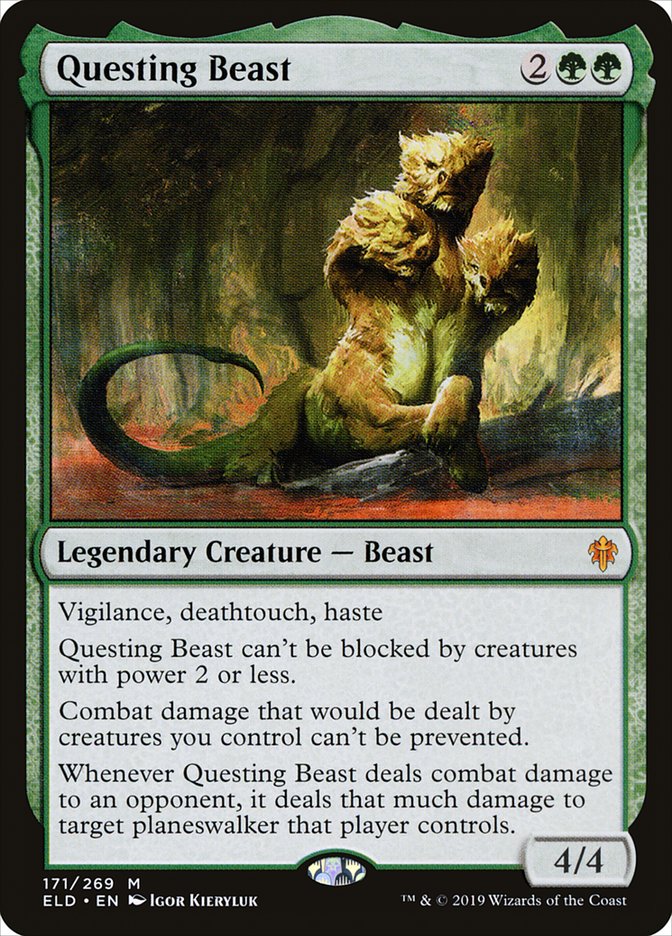
the infamously wordy Questing Beast could be improved by removing really any of the last three lines. is the idea that each head has one keyword and one other effect? i dunno. not worth it.
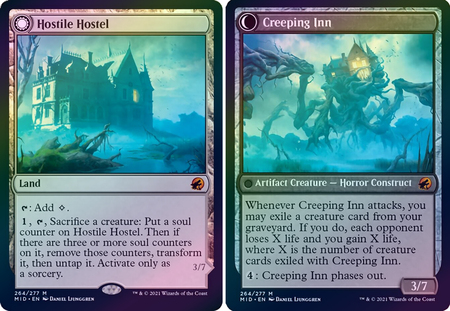
Hostile Hostel is fine (templating forces it to be wordy, but not unnecessarily so. its back face Creeping Inn is confusing, though. its abilities are not punchy or flavorful, either, in my opinion. instead, exiling cards from your graveyard could put +1/+1 counters on Creeping Inn. or you could remove the exiling cards part and just have its ability trigger on all attacks. also why can it phase out? what’s the point of that?

unlike the previous cards, i’m not interested in keeping anything here. this is a Mythic Rare! this is supposed to be punchy! instead it has two abilities that don’t relate to each other, aren’t flavorful, and would fit better on uncommon creatures. keep flash, but add a different ability, like “When Annie Flash enters, deal 3 damage to each opponent for each crime they committed this turn.” idk what she’s about in the lore, but it seems like a fun design.
obvious cash grabs. the cross-promotions and the horrible $999 30th anniversary product are annoying. and the “Secret Lair” drops and the alternate art printings are kind of cool, but i think they somewhat prey on people who have a poor understanding of money or some kind of compulsion to collect. they’re limited-time-only offers for maximum FOMO, and from what i can tell it costs $30 for sometimes as few as 4 cards—or $40 if you want them to be shiny! MtG isn’t the only product like this, but i still think there’s something wrong when people spend thousands of dollars on cardboard.
in which i compare MtG to marvel
marvel’s ‘the avengers’ is another franchise that cannot stop creating new content, lest they stop making as much money. audiences don’t go to movie theaters to watch old movies, even if the old movies are better. much like MtG, the amount of movies has benefits, namely that fans of a specific character or genre have lots of movies in the franchise to enjoy. but it has drawbacks: the movie equivalent of power creep is the perceived need for every sequel in a series to raise the stakes, until finally the stakes are comically, unbelievably high.
some other comparisons hold as well. for example, in both avengers and MtG i consider the aesthetic to be sleek, modern, and corporate to the point of detriment; and both franchises have received some backlash for the high pace of releases. it also bears noting that MtG’s cast of planeswalkers are essentially superheroes who do avengers stuff and sometimes band together to do an Infinity War and an Endgame (see: war of the spark).
what’s a girl to do?
at this point, i think Magic: the Gathering is past the point of no return. they’re all-in on a release schedule i consider unsustainable for the long term, a corporate aesthetic, an avengers-style story, and a focus on Commander. the game is not going to be “for me” ever again, unless they start running sanctioned three-card blind tournaments.1
i think they could make some incremental improvements, like returning to a more hand-drawn aesthetic or reducing the wordiness of cards, but that misses the point. it’s like suggesting how they could change Fast and Furious 12 to finally revitalize the franchise; sometimes it’s better to just stop and create something new. why can’t WotC just make a new game? it’s not as though good ideas for collectible card games are exhausted, and WotC would have an easier time than nearly any other company at marketing such a game. it would grant a fresh slate and they would have 30 years of learnings to draw on.
but i can’t deny, it would be a big risk. and that’s not what corporations are about. especially not when the cash cow hasn’t yet been milked for all it’s worth. that’s why i’m not holding out hope, and i’d rather find a new strategy game to scratch that itch or invent one myself. i have some ideas (and i have my eye on Slay the Spire 2), but it’s admittedly very hard.
in the meantime, here’s what a girl’s to do: complain about it on the internet (:
-
my favorite niche format is three-card blind, a format mostly like regular MtG but where your deck must have only three cards total. and then you do a big tournament between secretly submitted decks, with results decided assuming players have perfect information and play optimally. the constraint forces you to examine the game through a completely different lens and has some (in my opinion) fascinating emergent strategies. you couldn’t make this type of format and have it be interesting in nearly any other game. ↩↩
-
and some others that are banned because they’re too racist ↩
-
this isn’t such a new problem. maybe the most egregiously dull twist is Megamorph, which makes a dull, unmotivated modification to the Morph mechanic while having a name that makes that fact as obvious as could be. ↩
-
or, back, as it were ↩